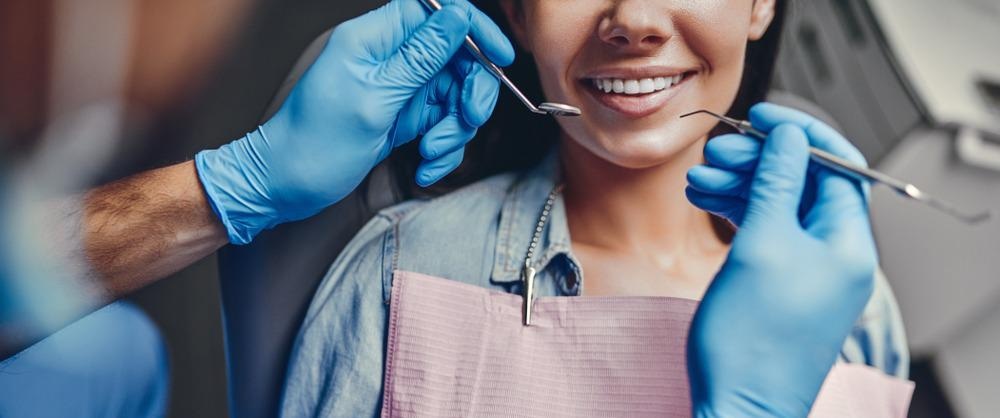Bioactive glasses (BAGs) are used in dental care because of their cytocompatibility and strong cellular adhesion potential, according to a new study published in the journal Dental Materials. The researchers address the foundations of sol-gel-generated BAGs and their usage as dental cell substitute material.

Study: Sol-gel bioactive glass containing biomaterials for restorative dentistry: A review. Image Credit: 4 PM production/Shutterstock.com
Sol-gel BAGs are mostly used for hypersensitive dentine treatment and pulp-dentine tissue engineering, with some also employed for target medicine administration. Biological properties, antibacterial effects, hardness, acid buffering, and remineralization can all be improved using BAG fillers.
Bioactive Materials in Dentistry
Dental decay is one of the most likely reasons for oral disease in the world. As a result, the use of different dental biomaterials to rebuild tooth structure, improve functionality, remove discomfort, and improve aesthetics accounts for a major share of doctor appointments. Indeed, a large percentage of dental research is devoted to dental composites, with a particular focus on developing bioactive regenerative dental solutions.
Materials are classified as elastomeric, ceramics, composites, or metals, depending on their principal composition. According to a recent analysis of current developments in dental advanced materials, while bioactive material advancements are on the rise, non-bioactive dental cement, and metal/alloy-based composites are on the decline.
Certainly, nanomaterials that participate actively in tissue repair are becoming more popular than passive and inorganic substances. Bioactive compounds for regenerative dental treatment are often classified as materials having remineralization capabilities for various applications, including pulp sealing, plastic tooth fillings, dental compaction, and bonding.
Dental Materials Incorporating Bioactive Glasses (BAGs)
About fifty years ago, bioactive glass (BAG) was found as a reactive synthetic (silicate) material. It has been determined that a biopolymer is bioactive if it can create a hydroxyapatite surface using absorption solutions that do not contain calcium or phosphate ions.
More from AZoM: What is Femtosecond Laser-Based 3D Printing?
BAGs have been employed as prostheses and implant coverings, dental or molar bone cavity replacements, facial floor reconstructions, teeth sensitivity controls, and as fillers in various materials in dental, oral, and maxillofacial procedures. Even though BAG fillers have been utilized as dental fillers, oral prosthetics, and even imprint substances, this research focuses primarily on the use of sol-gel-derived BAGs indirect resin composites such as sealants, DRCs, cement, and numbing procedures.
Limitations of Previous Studies
There has been no prior research on the usage of sol-gel-generated BAGs in restorative dental therapy. Several studies on BAGs and oral health make no distinction between preparation methods or kinds of BAGs. Although a prior comprehensive study of sol-gel BAGs concentrated on biocompatibility and antimicrobial activities, it failed to differentiate between tooth structure and alveolar tissue repair applicability. Similarly, a recent study on BAG-containing dental materials only looks at resin-based compounds, which are just one type of regenerative filling material.
Current Research on Sol-gel based BAGs
The present research examines the physical and chemical, pharmacological, and physiological effects of novel dental resin composites, such as sol-gel BAGs. The testing conditions and issues are detailed to stimulate further discussion and consensus, which should improve the quality and consistency of BAG studies in biomaterials. The goal of this study was to demonstrate the wide range of BAG formulations, structures, and characteristics for application in dental restorative materials.
Research Findings and Conclusion
Because they are reactive and can be created to enhance composites, sol-gel-based BAGs have sparked a great deal of interest as orthodontic biomaterials. These materials can be utilized to replace molar fillings and for biomimetic, less invasive dentistry. Although the majority of the research has shown excellent results, cautious optimism is necessary owing to selective evaluations that do not completely gauge material performance. Furthermore, although the majority of research was conducted in vitro, the oral ecosystem has unique dynamics that might have a significant impact on the outcomes.
For example, significant pulpal infection of primary dentition led to therapeutic failure (infection, abscess formation, and pain) and early study abandonment in a 45S5 BAG clinical trial. This implies that only well-designed clinical studies can be expected to turn knowledge into marketable products. R&D teams must work together with dentists and biomaterial experts to provide robust data that will guide future progress from tabletop studies to meaningful patient outcomes. At this level, however, regulating in vitro research is still necessary to deliver precise and reproducible findings.
Further Reading
Simila, H. O. et al. (2022). Sol-gel bioactive glass containing biomaterials for restorative dentistry: A review. Dental Materials. Available at: https://www.sciencedirect.com/science/article/pii/S0109564122000598?via%3Dihub
Disclaimer: The views expressed here are those of the author expressed in their private capacity and do not necessarily represent the views of AZoM.com Limited T/A AZoNetwork the owner and operator of this website. This disclaimer forms part of the Terms and conditions of use of this website.